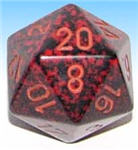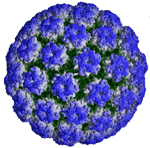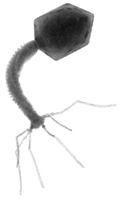Icosahedron
A 3D shape with 20 flat faces
Notice these interesting things:
- It has 20 faces
- It has 30 edges
- It has 12 vertices (corner points)
When it is regular:
- Each face is an equilateral triangle
- At each vertex 5 edges meet
- It is one of the Platonic Solids
Volume and Surface Area
For a regular icosahedron (where all faces are equilateral triangles):
The name icosahedron comes from the Greek icosa- meaning 20, because it is a polyhedron with 20 faces.
When we have more than one icosahedron they are called icosahedra
When we say "icosahedron" we often mean "regular icosahedron" (all faces are equal equilateral triangles), but it doesn't have to be - this is also an icosahedron, even though all faces are not the same.

20-Sided Dice? Yes! An icosahedron that has 20 equal faces has an equal chance of landing on any face.
In fact, you can make fair dice out of all of the Platonic Solids.

The outer shell of this virus (the Human papilloma virus) is like an icosahedron
Courtesy of VirusWorld at virology.wisc.edu
The head of a bacteriophage (a virus that targets bacteria) is an icosahedron
Illustration of bacteriophage

Photo courtesy of Wikpedia user Kuksi
| Make your own Icosahedron, cut out the shape and glue it together. |
|

Soccer Ball
A soccer ball is related to an icosahedron:
It is a truncated icosahedron (truncated means it has bits chopped off it) where each face has been cut off to form a mix of pentagons and hexagons.
It has 12 pentagons and 20 hexagons